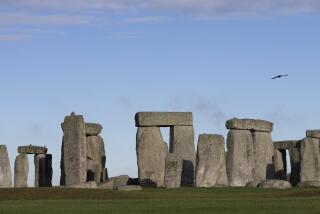London Stone shrouded in mystery and myths
- Share via
Reporting from London — It isn’t much to look at: a gray lump of rock behind an ugly metal grill, attached to an even uglier building. You have to crouch down to see it, and its admittedly modest (or maybe nonexistent) charm can seem trifling compared with the glories of St. Paul’s Cathedral or Westminster Abbey.
Unloved and neglected, lost in the shadows of gleaming bank towers and the bustle of a city hard at work, the London Stone gets short shrift from the tourist hordes and even Londoners themselves. But it’s one of the city’s most ancient and storied relics. Modern legend even says London’s existence depends on it.
This chunk of limestone has sat in or around the same spot on present-day Cannon Street, in London’s financial district, for at least one millennium, possibly two, throwing up mysteries and inspiring myths as to its origins and purpose.
Was it a mile marker? Did it represent the center of London? Was it a place of sacrifice, a symbol of authority, a source of mystical power, a guardian spirit?
No one knows for sure. But Shakespeare, Charles Dickens and poet William Blake all wrote about the stone. One 15th century rebel declared himself ruler of London by striking it with his sword.
Its fame put it among an elite group of rocks and boulders in the British Isles: Stonehenge in southern England, the Blarney Stone in Ireland and the Stone of Scone in Scotland, which is still used in the coronation of British kings and queens.
Unlike the others, however, the London Stone has slipped out of the collective consciousness.
“It’s an iconic stone, but I don’t think many people know about it,” said Andy Round, who works at a nearby financial firm. “If you stop people on Cannon Street and ask, ‘What is the London Stone?’ they’d probably look at you blankly.”
Although it’s not much bigger than a hatbox now, the block once crowned a larger slab set deep in the ground. Grooves along the top appear to attest to some sort of human use.
According to John Clark, an expert in medieval history who worked for many years at the Museum of London, the stone may have been brought here by the Romans and erected as a monument in the forecourt of a grand palace close to the current site. Or perhaps the Saxons planted it there, smack in the center of a new grid of streets built under King Alfred, who resurrected London in 886 after it was sacked by the Vikings.
In 1450, Jack Cade, the leader of a peasant uprising, entered the city, whacked the stone with his sword, proclaimed himself “Lord of London” and, as immortalized by Shakespeare in “Henry VI, Part II,” issued his first decrees while sitting on it, as though on a throne. (It’s Cade’s sidekick, Dick the Butcher, who urges: “The first thing we do, let’s kill all the lawyers.”)
Historians and writers down the centuries have suggested that distances in Roman Britain were measured from the stone, that druids worshiped it, that debts were paid at the stone and that political authority flowed from it.
In the 19th century, it developed talismanic significance. A popular myth claimed that the stone had arrived in Britain with Brutus, a leader of ancient Troy, who used it as an altar to the goddess Diana.
Like the legend of the ravens at the Tower of London, whose presence supposedly guarantees the reign of the monarchy, the fate of the city became tied to the monolith.
“So long as the Stone of Brutus is safe, so long will London flourish,” the saying goes, which probably explains why, in a newspaper photo from the 1920s, a mustachioed policeman is shown keeping watch over the stone.
By then, the venerable old block had already been moved several times (once because it was deemed a traffic hazard) but always only a few steps away from its original location.
Now it rests in a low glassed-in alcove carved into the front of a drab and now-empty building that once housed the Bank of China and a sporting goods store. A small plaque provides a brief explanation; the rusting iron grill offers a bit of protection but also tends to block the stone.
“I worked here for two months before I even saw it,” said Therese Persson, a bartender at a nearby pub named after the London Stone.
The ancient stone might get a little more respect soon. Peter Wynne Rees, a planning officer with the city of London, said a proposal has been put forward to move the stone to a building close by, where it would enjoy a more conspicuous presentation.
It won’t answer the riddle of why the London Stone assumed such significance. But that’s fine with Rees.
“It’s nice to have something that everybody knows is really old but nobody knows for sure what it was for,” he said. “It’s one of those enigmas that’ll never get solved.”


